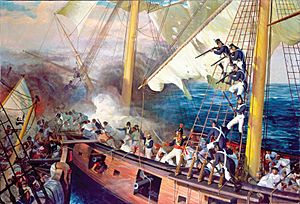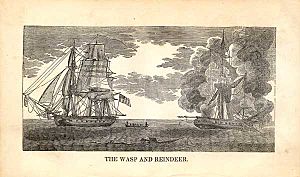Sinking of HMS Reindeer facts for kids
Quick facts for kids USS Wasp vs HMS Reindeer |
|||||||
|---|---|---|---|---|---|---|---|
| Part of the War of 1812 | |||||||
 Marines aboard USS Wasp engage the British on HMS Reindeer |
|||||||
|
|||||||
| Belligerents | |||||||
| Commanders and leaders | |||||||
| Johnston Blakely | William Manners | ||||||
| Strength | |||||||
| 1 sloop-of-war 173 crew: U.S. Navy U.S. Marines |
1 brig-sloop 118 crew: Royal Navy Royal Marines |
||||||
| Casualties and losses | |||||||
| 9 killed 15 wounded |
25 killed 42 wounded Reindeer sunk |
||||||
The sinking of HMS Reindeer was a very tough naval battle during the War of 1812 between America and Britain. It happened on June 28, 1814. The American ship, USS Wasp, which was a type of warship called a sloop-of-war, fought against the British ship, HMS Reindeer. Reindeer was a brig-sloop, a smaller type of warship. The battle was so fierce that more than half of Reindeer's crew, including its Captain, were killed or hurt. Reindeer was too damaged to be fixed, so the Americans set it on fire.
Getting Ready for Battle
USS Wasp was one of three powerful sloops-of-war designed by William Doughty. It was launched in Portsmouth, New Hampshire, and began its mission on May 1, 1814. The ship's commander was Master Commandant Johnston Blakely. He had a crew of 173 skilled sailors from New England. Blakely's orders were to attack British merchant ships near the English Channel. This was similar to what another American ship, USS Argus, had done successfully the year before.
Over several weeks, Commander Blakely's crew captured seven British merchant ships. On the morning of June 28, Wasp was chasing two more merchant ships. That's when they spotted the British brig-sloop Reindeer sailing towards them. Reindeer had left Plymouth a few days earlier. Its mission was to find and stop Wasp.
The Fierce Fight at Sea
USS Wasp was bigger and had more powerful guns than Reindeer. Wasp had twenty-two 32-pounder carronades (short-range cannons) and two 12-pounder chase guns (used for firing forwards or backwards). Reindeer had eighteen 24-pounder carronades. It also had two 6-pounder bow chase guns. Interestingly, Reindeer's captain, William Manners, used a 12-pounder carronade from his ship's boat very effectively during the battle.
The day was cloudy, and the wind was very light. It took a long time for the two ships to get close enough to fight. When they were about 60 yards apart, Reindeer was behind Wasp. From this position, Captain Manners fired his boat carronade five times over ten minutes. Eventually, Commander Blakely turned Wasp to face Reindeer directly. This allowed both ships to fire their main cannons, called a "broadside," at each other. They were almost still in the water as they exchanged fire.
After about twenty minutes of intense firing, the two ships crashed into each other. Some British sailors tried to board Wasp (jump onto the enemy ship), but the American crew fought them off. Commander Manners of Reindeer was badly wounded, but he kept encouraging his crew. He was then killed by a musket shot from Wasp's rigging. American boarding parties then jumped onto Reindeer. They quickly took control of the ship. The British captain's clerk, who was one of the few officers left, surrendered.
Reindeer suffered heavy losses. Twenty-five of its crew were killed, including Captain Manners. Forty-two more were wounded. This was out of a total of 98 men and 20 boys. On Wasp, two midshipmen (junior officers) and nine sailors or marines were killed or mortally wounded. Fifteen other petty officers, sailors, and marines were wounded.
What Happened Next
The American victory was mainly because Wasp had more powerful guns and a larger crew. The number of casualties on both sides showed how evenly matched the fight was, considering the difference in ship power.
Reindeer was completely destroyed. Commander Blakely set it on fire. He then put some of the wounded British prisoners onto a neutral ship. After that, Wasp sailed to Lorient, a port in France. At this time, France was officially neutral in the war between Britain and the United States. However, France generally supported the Americans. Blakely had to stay in Lorient for seven weeks to repair Wasp's damaged masts. The British ambassador protested, but the French ignored his complaints.
After leaving Lorient, USS Wasp won more battles in the English Channel. However, it later disappeared in the South Atlantic. It is believed that the ship was lost in bad weather.
Images for kids



